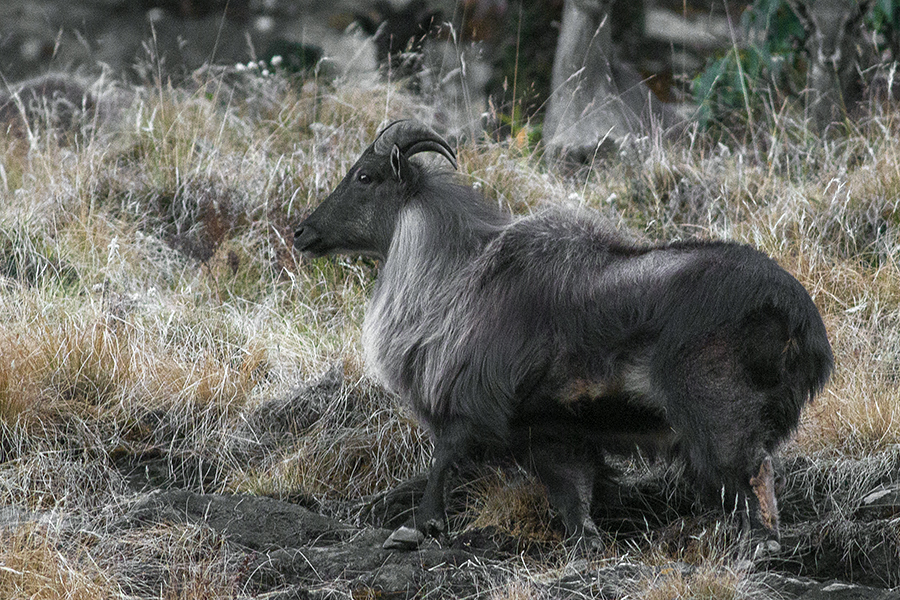Western Himalayan Subalpine Conifer Forests
The ecoregion’s land area is provided in units of 1,000 hectares. The protection goal is the Global Safety Net (GSN1) area for the given ecoregion. The protection level indicates the percentage of the GSN goal that is currently protected on a scale of 0-10. N/A means data is not available at this time.
Bioregion: Himalayan Mixed Forests & Grasslands (IM5)
Realm: Indomalaya
Ecoregion Size (1000 ha):
3,976
Ecoregion ID:
310
Protection Goal:
23%
Protection Level:
4
States: India, Nepal, Pakistan
These subalpine conifer forests represent the tree-line transitional zone from the forested Himalayan ecoregions to the treeless alpine meadows and boulder-strewn screes above, and separate the forest-dwelling species such as common leopards, musk deer, and red pandas from the forest-avoiding species such as snow leopards, Himalayan wolves, and a number of large Himalayan alpine goats and sheep.

The flagship species of the Western Himalayan Subalpine Conifer Forests ecoregion is the musk deer. Image credit: Creative Commons
The ecoregion is narrow with a width between 3,000 and 3,500 m, extending west from the Kali Gandaki River in central Nepal through northwestern India into eastern Pakistan. Now, climate change may be pushing the forests upslope. The conifer forests in the drier western regions of the Himalaya, with blue pine, chilgoza pine, fir, silver fir, and spruce are more diverse and extensive than those in the moister eastern ranges.
The Himalayas are geologically young, dating back to a period about 50 million years ago, when the northward-drifting Deccan Plateau collided with the Eurasian continent, creating geological upheavals that gave rise to the Himalaya, that now stretches for more than 3,000 km, from Pakistan to Myanmar. The mountains are comprised of three distinct ranges, and this ecoregion lies in the middle Himalayan range, which rises to about 5,000 m.

Markhor. Image credit: Creative Commons
The climate is seasonal. The ecoregion receives about 1,500 mm of rainfall during the summer monsoon that sweeps in from the Bay of Bengal to the east. But low pressure winter weather systems that arrive from the west also bring heavy snowfall. The monsoon rains are intercepted in the eastern Himalayas; thus the western extent receives about a third of the precipitation that the eastern Himalaya receives. This moisture gradient influences the vegetation, manifested as a lower treeline, at about 3,300 m, in the west, compared to 4,000 m in the east.
The ecoregion has several recognizable forest types: pure fir forest; mixed oak-fir forest; mixed rhododendron, fir, and birch forest; and mixed coniferous forests with fir, blue pine, and spruce. Cypress and Himalayan cedar or deodar are common above 2,400 m.

Himalayan serow. Image credit: Dibyendu Ash, Creative Commons
These conifer forests in the western Himalaya immediately below the alpine meadows do not have a spectacularly rich fauna or flora, but do harbor several threatened species of conservation importance, especially the brown bear, and of course the musk deer and red panda. The ecoregion’s bird fauna consists of 285 species, with several pheasants and tragopans—Koklass pheasant, western tragopan, and Himalayan monal—that are characteristic of these sub-alpine western Himalayan forests and have low disturbance thresholds. The Himalayan griffon, a large bird of prey that soars above the mountains, embodies the aura of space in the high Himalayas.

Himalayan tahr. Image credit: Dibyendu Ash, Creative Commons
Although the ecoregion is less populated by people than some of the other Himalayan ecoregions, large areas of natural forests have been cleared or degraded for timber, agriculture, and fuelwood harvesting. Collection of morel mushrooms coincide with the breeding seasons of forest birds. Nevertheless, the ecoregion still has some of the least disturbed forests in the western Himalayas. Eleven protected areas that extend across the ecoregion covers about 9% of its area. Notable among these are Kistwar, Royal Dhorpatan, and Rupti Bhabha.
The priority conservation actions are to: 1) monitor and regulate wild mushrooms collection to minimize disturbances to breeding birds and mammals; 2) integrate this ecoregion into conservation landscapes to maintain altitudinal connectivity with other ecoregions; and 3) engage local communities as stewards to conserve the remaining habitats outside of protected areas.
Citations
1. Wikramanayake, E, E. Dinerstein, et al. 2002. Terrestrial Ecoregions of the Indo-Pacific: A Conservation Assessment. Island Press.
2. Yadava, A.K., Sharma, Y.K., Dubey, B., Singh, J., Singh, V., Bhutiyani, M.R., Yadav, R.R. and Misra, K.G., 2016. Altitudinal treeline dynamics of Himalayan pine in western Himalaya, India. Quaternary International.
3. Ahmed, M., Husain, T., Sheikh, A.H., Hussain, S.S. and Siddiqui, M.F., 2006. Phytosociology and structure of Himalayan forests from different climatic zones of Pakistan. Pakistan Journal of Botany, 38(2), p.361.


